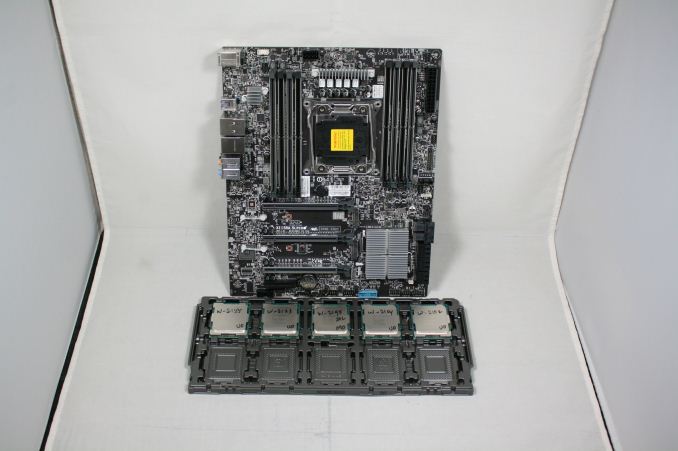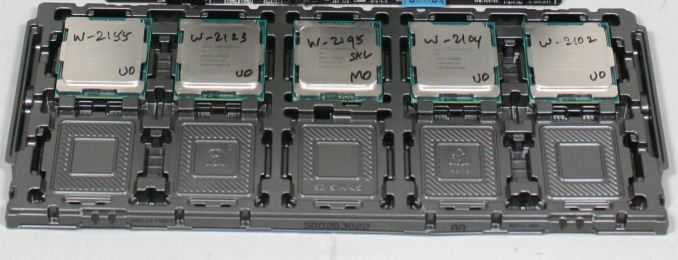The Intel Xeon W Review: W-2195, W-2155, W-2123, W-2104 and W-2102 Tested
by Ian Cutress & Joe Shields on July 30, 2018 1:00 PM EST- Posted in
- CPUs
- Intel
- Xeon
- Workstation
- ECC
- Skylake-SP
- Skylake-X
- Xeon-W
- Xeon Scalable
Conclusion: Is Intel Serious About Xeon W?
In this review, we have covered the performance on three of the more popular Xeon W processors, as well as two off-roadmap parts, and discussed that the Intel’s decision to bifurcate the way its workstation and consumer processors work has put more questions on the table for prospective buyers.
This ultimately comes down to the question: Is Intel Serious About Xeon W? If we ask Intel about this, of course the answer to them is yes – they want to have target markets and have a product portfolio that they feel will fit with that user base. However I am not so sure.
Xeon W was launched a lot later than both the Xeon Scalable platform and the equivalent Skylake-X consumer platform. The messaging behind Xeon W is unclear to a large degree, with only a limited amount of PR invested into it, unlike Xeon Scalable or Skylake-X. The decision to split the market between consumer and workstation, despite having a common socket, has minimized the accessibility of the workstation platform: fewer discussions are being had about the hardware, because there’s little room for a truly mix-and-match scenario as with previous generations. At no point in Intel’s messaging were we offered review samples for example, which is usually an indication that the product line is not one that the product managers are looking to promote. Only Intel’s latest Xeon E designs, released 10 months after the first equivalent consumer parts, beats Xeon W in terms of how un-exciting it can be to try and discuss talking about a platform. Intel does not want to sample Xeon E, either.
So will Intel lose workstation market share to AMD? If I am being so pallid, what are the financial ramifications for this market? AMD’s Threadripper looks like an appealing platform for workstation users for sure, but AMD is not without its own issues. Intel is the incumbent, and has embedded itself with a large number of OEMs and end-users for years, making it difficult for AMD to break that market. AMD’s chiplet design will take a few generations to get used to, so users might stick with ‘what they know’, regardless of any cost/benefit analysis. There is also the discussion of ECC support on Threadripper, for which the messaging has been somewhat unclear: technically it should support up to ECC LRDIMMs, however it does depend a lot on whether the motherboard vendor has qualified their product for RDIMMs or LRDIMMs – most of them are not, complicating the issue. If AMD wanted to tackle this space, they need an ASUS or a GIGABYTE to build a ‘workstation focused’ motherboard, with confirmed ECC and co-processor support. GIGABYTE’s Designare line and MSI’s upcoming X399 Creation might be aimed at this, but it really does require a razor-sharp message to get through.
All this confusion means that while AMD can be competitive in most tests, Intel is expected to remain the market leader for the foreseeable future.
I’m Sold on Xeon W: Tell Me About Performance
As our benchmarks are anything to go by, there is a lot of parity in performance between Intel’s Xeon W and Intel’s Skylake-X product lines. Xeon W takes a hit in memory workloads, because of the memory support: ECC RDIMMs are typically run at base JEDEC sub-timings, and so our DDR4-2666 memory was run at 19-19-19, compared to the 16-16-17 on the consumer platform which is more typical.
Our Xeon W results are skewed a bit towards the low-end processors, mostly because three of the five units we managed to acquire were quad-core processors. At this level, Intel’s now EOL Kaby Lake-X processors fared better, or the consumer Coffee Lake-S look like the better option, unless the user needs ECC or more PCIe lanes than the consumer products provide. The obvious counterpoint here is that if a user needs ECC, and is happy with 64 GB maximum memory support, then Intel’s own Xeon E is also an option, however we have not tested those parts yet (if any OEM can sample them to us, please let us know).
On the high-end, we do see the W-2195 sit behind the Core i9-7980XE in almost all benchmarks, which also means that for embarrassingly parallel workloads, it also sits behind the Threadripper 1950X. It still holds that Intel’s single threaded performance of the Xeon W, despite the lack of Turbo Boost 3.0, still gives it a significant advantage in single threaded workloads over AMD.
For users worrying about Spectre and Meltdown patches affecting performance, in our SYSMark tests we saw a 2-6% decrease over all the tests, with the hardest hit tests seeing a 12% decrease due to the correlation with storage.
Why Buy Xeon W?
The obvious reasons to buy Xeon W processors are just tick boxes: ECC memory, PCIe lanes, co-processor verification. If these are needed, the number of options for the rest of the system (particularly the motherboard) becomes slim, especially when factoring in price and total cost of ownership. A lot of the workstation market works on development cycles and high-throughput compute: the faster the compute, the quicker the prototyping. The fastest processors for a lot of that work, if CPU bound, are won by the consumer Core i9 or Threadripper, however if the above boxes are ticked, then Xeon W would be needed. Or Xeon Scalable, depending on budget.
A small side note to end: If anyone has access to any of the Apple-only Xeons (like the W-2150B) and would kindly let us borrow it for a review, please let me know over email.












74 Comments
View All Comments
Lolimaster - Tuesday, July 31, 2018 - link
I see no point in this when TR exist, not only 1950X already crushes but the 2990X will just made them an afterthought.cm2187 - Tuesday, July 31, 2018 - link
It says “workstation” but is there any reason not to base an entry level server on these specs? Cheaper than server chips, ample of ram, ECC, vpro. Is there anything Intel will do to enforce a segmentation?GreenReaper - Monday, August 6, 2018 - link
That is almost certainly one of the purposes of the custom 4-core editions. HP's MicroServer Gen8 had a two-core 2.3Ghz Celeron with ECC support - this has significantly more wattage but I'd expect to see it in hardware with a need for long-term highly-reliable duty like communications equipment.buxe2quec - Tuesday, July 31, 2018 - link
This may be a stupid question, but how come my E3-1220 (3.1 GHz) from 2011 has 80 W TDP and this Xeon W-2104 (first table) has 120 W?I thought that power consumption went down per MHz... this is 50% increase.
buxe2quec - Tuesday, July 31, 2018 - link
I saw the numbers on page 2 about the real tests, but I don't have the ones for the E3-1220 to compare the actual values, so I was comparing only nominal TDP.Hamm Burger - Tuesday, July 31, 2018 - link
I'm lucky enough to be using a 10-core iMac Pro, so have the Apple-specific W-2150B. I'm afraid I'm not about to prise it out of the system so that you can test it, but here's the result of one anecdotal test: running the CPU portion of Cinebench 15 for macOS gives a mutithreaded score of 2012 and single-threaded of 182 — a spot below your figures for the W-2195. Also, Intel Power Gadget shows the CPU drawing 150W, with the cores hitting almost 100° during the multithreaded test.abufrejoval - Tuesday, July 31, 2018 - link
I guess Intel wants to ensure AMD Threadripper gets the home-grown workstation market going forward…Like you mention, previous generation CPUs, even high core count variants are floating around in the second hand market and I got myself an OEM variant of the E5-2699v3 (E5-2696v) about two years back for around $700 from China via eBay (“extremely affordable”). That’s an 18core chip that will clock a little higher than the 2699, 3.6GHz instead of 3.3 when fewer cores are used, while the all-core clocks and TDP (145 Watts) are the same.
I am running this in an X99 board with 128GB of ECC UDIMM (bought before the RAM prices hiked 100%) and operating it with a BCLK overclock of 103.8, which results in a clean 4GHz for low-core workloads, 3.8GHz with four cores active and 2.8GHz for all-core unless it’s AVX workloads (prime95), where it may drop to 2.6GHz, all with well below 140 Watts and generally quite cool with an unnoticeable Noctua fan inside a $60 cheapo tower.
It runs games rather well, clocking high on the few cores most game engines use and it also does well using lots of cores on things like massive compile jobs (make -j40) or machine learning tasks (helped along by GTX 1080ti where GPUs are better).
It gets 2552 on Cinebench R15, so it won’t quite beat the current generation Threadrippers or these Xeons, but at the premium prices Intel wants to charge for Xeon-W as well as current DRAM prices, I simply couldn’t afford something in this league for the home-lab.
abufrejoval - Tuesday, July 31, 2018 - link
Here is a Geekbench result for this rig: https://browser.geekbench.com/v4/cpu/9220520alpha754293 - Thursday, August 2, 2018 - link
The other reason why someone might consider the Xeon W (such as myself) - high memory and need a very fast single threaded performance.The consumer parts are limited to 64 GB (ECC or not) of RAM whereas the Xeon W caps out at 512 GB.
Most "normal" people might not need that, but I can tell you right now that for some of the pre and post-processing work that I do, I'm looking now at either a 256 or 512 GB system with very fast single threaded performance.
Dug - Thursday, August 2, 2018 - link
I know you've heard it before, but just want to throw in my 2 cents.Could you please try a newer version of Handbrake for H.256 benchmarks. I know when doing comparisons you need consistency and it's best to stick with one version, but x265 is becoming very popular, and the new version fixes previous x265 issues. Plus they have new Production presets which might be helpful. Thanks for any consideration.